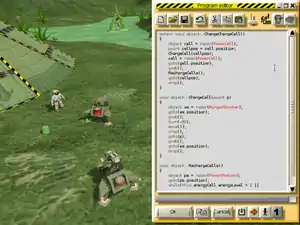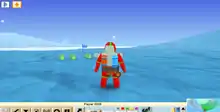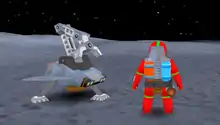Colobot
Colobot (Colonize with Bots) is an educational real-time strategy video game featuring 3D graphics, created by Swiss developer Epsitec SA. The objective of the game is to find a planet for colonization by the human race by establishing a basic infrastructure on the surface and eliminating any alien life forms endangering the expedition. The game takes place on the Earth, Moon, and seven fictional planets. The main feature of the game, which makes it educational, is the possibility for players to program their robots using a programming language similar to C++ or Java.
| Original author(s) | Epsitec SA |
|---|---|
| Developer(s) | ICC & TerranovaTeam |
| Initial release | 2001 |
| Preview release | 0.1.12
/ 24 February 2019 |
| Repository | |
| Operating system | Linux, Windows |
| Platform | Cross-platform |
| Type | Real-time strategy |
| License | GPLv3+ |
| Website | colobot |

Plot overview
Life on earth is threatened by a devastating cataclysm, forcing mankind to move out and search for a new home. A first expedition composed solely of robots was sent to find another habitable planet. However, for unknown reasons, the mission was a disaster and never returned.
With only a few robots for companions, the player must travel to new planets. Houston, Earth Mission Control as well as a spy satellite will transmit valuable information to the player. The player needs to build the infrastructure necessary to gather raw materials, energy supplies, and produce the weapons necessary to defend themselves. By programming robots, the player can delegate tasks to them, allowing the player to continue their mission while their robots upkeep the base, fight off enemies, harvest materials, and perform any other tasks assigned to them.
Missions

In the game, the player explores Earth, Moon and seven fictional planets.
| No | Level's name | Planet | Characteristics |
|---|---|---|---|
| 1 | Leaving Earth | Earth | The planet where the game begins. |
| 2 | On the Moon | Moon | Where the previous expedition was last seen. |
| 3 | On Tropica | Tropica | Tropical planet. |
| 4 | On Crystalium | Crystalium | A low-temperature planet featuring crystals. |
| 5 | On Saari | Saari | Desert planet. |
| 6 | On Volcano | Volcano | Volcanic planet. |
| 7 | On Centuary | Centuary | Dry planet. |
| 8 | On Orpheon | Orpheon | Electric planet. |
| 9 | On Terranova | Terranova | Planet similar to Earth. |
Language overview

The programming language used in Colobot is CBOT, syntactically similar to C++ and Java. Example code for a bot to find a piece of titanium ore and deliver it to a purification facility:
extern void object::FetchTitanium()
{
object item; // declare variable
item = radar(TitaniumOre); // find a piece of titanium ore
goto(item.position); // go to the ore
grab(); // pick up whatever is in front of the robot (presumably the ore)
item = radar(Converter); // find the ore converter
goto(item.position); // relocate to the converter
drop(); // drop the piece of ore
move(-2.5); // back up 2.5 meters to allow the converter to start processing the ore
}
Legacy
Epsitec released the games' source code in October 2014 under GNU GPL v3 after being contacted by the Polish game enthusiast community PPC.[1]
ICC & TerranovaTeam (formerly PPC[2]) was given the source code by Epsitec under the GPLv3 license.[1] Terranova is in the process of updating the game, titled Colobot: Gold Edition. They are also working on a sequel: Colobot 2, aiming for a Steam release; however, this goal has not been accomplished yet.
Similar games
CeeBot, also made by Epsitec, is a very similar series of games spanning 4 titles.
- CeeBot-A - An expansion of Colobot's Exercises & Challenges.
- CeeBot-Teen - Geared to and simplified for a younger audience. Has basic programming exercises.
- CeeBot3 - A program-to-paint programming course that allows students to make drawings & animations
- CeeBot4 - A major programming course for college students & audiences in the programming field.
Reception
The game has been recommended by the Polish Ministry of National Education as a teaching aid for learning the basics of algorithms and object-oriented programming.[3]
External links
- Epsitec Colobot webpage
- Colobot: Gold Edition website - International Colobot Community
- Colobot at MobyGames
References
- License
- Rebranded Name for PPC
- (in Polish) Educational aids - site of Ministry of National Education of the Republic of Poland Archived 2008-02-16 at the Wayback Machine